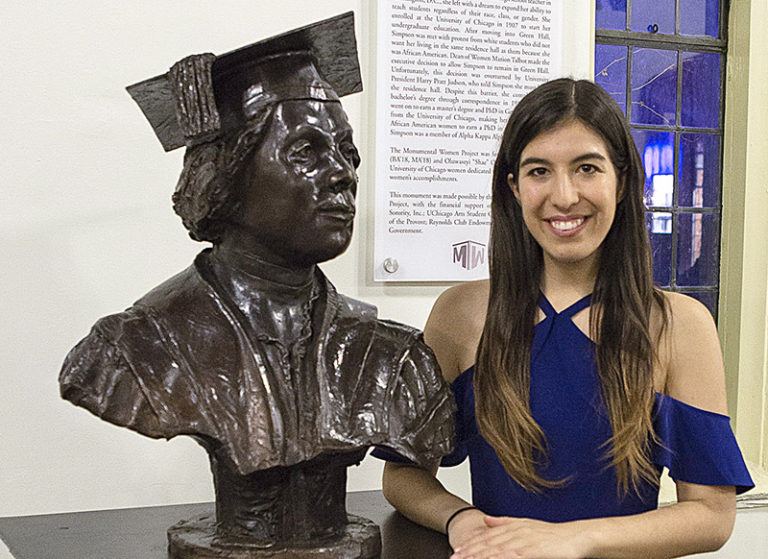For decades, the story of a remarkable woman lay forgotten in the archives of the University of Chicago. That woman was Dr. Georgiana Simpson, the first black woman at the University—and one of the first in the entire country—to earn a doctoral degree. Her story is being told and celebrated today because of the efforts of two students at the University of Chicago: KCD grad Asya Akca ’14 and her UChicago classmate Shae Omonijo.
Asya and Shae are co-founders of the Monumental Women Project, whose mission is to create public art honoring historic women. With the unveiling this fall of a bronze bust honoring Dr. Simpson, they’re celebrating the fruition of years of planning, fundraising, and hard work.
Asya met Shae during her first year at UChicago and recalls that “we had a mutual passion for understanding women’s history at the University.” Their interest soon coalesced around Dr. Simpson. “For us, Georgiana Simpson was the person whose story we needed to tell first,” Asya explained. “As a woman of color, she faced so many obstacles when she was on campus, but she was still able to maintain her academic focus and her drive and to complete her Ph. D. We really thought that her story would resonate with others here.”
That story is an inspirational one. Simpson was 55 in 1921, when she became the first black women at the University to earn her doctorate. As an undergrad, Simpson’s attempt to integrate a University dormitory sparked student outrage and unrest. Although Simpson’s right to equal housing was supported by Dean of Women Marian Talbot, University President Harry Pratt Judson forced Simpson to live off campus. Despite these obstacles, Simpson persisted. Through commuting, correspondence, and summer classes, she earned her undergraduate degree and ultimately a doctorate in German philology. She later joined the faculty of Howard University, where she worked to promote African American history and literature.
Today, the bust honoring Dr. Simpson stands in the University’s Reynolds Club, opposite a bronze relief of Harry Pratt Judson—the man who forced her out of campus housing. Asya points out that the Reynolds Club was reserved only for men while Simpson was on campus, a historical irony she finds delightful. She also explains that the juxtaposition of the Simpson and Judson pieces achieves one of the central goals of the Monumental Women Project. “That’s the kind of dialogue with history we are trying to create. What have we chosen to remember? What other stories need to be told? It’s a very powerful thing to put these monuments in dialogue—to try to tell a more complete story of the past. The big thing that Shae and I have been hoping is that this project will inspire others to discover the stories that deserve to be told but haven’t been. Hopefully, those stories can help shape our future.”
With the unveiling of the Simpson bust, Asya and Shae are contributing to a larger conversation about public art in America. When Asya left Louisville in 2014 to go to college, there wasn’t a single piece of public art in the city honoring a woman. [The first—a statue of Mother Catherine Spalding—was installed in 2015—Ed.] Things were much the same in Chicago and, Asya realized, across the country. The Monumental Women Project, she explained, is her and Shae’s attempt to address that imbalance.
“The whole purpose of monuments is that they seek respect, they ask for admiration,” Asya said. “You read their stories, see them as heroes. Public art pieces are a way to empower and inspire others to go on and pursue similar actions. Having very visible, tangible sources of inspiration is critical to girls as they’re growing up. If you don’t have enough women honored in the public spaces that people visit, you’re never going to have kids seeing women as figures they want to emulate. We want Georgiana Simpson and her story—as well as the stories of many other women—to inspire others and to empower them to take on these types of challenges and to pursue leadership roles in our society.”
Asya will graduate this spring with a master’s degree in international relations. Her dual masters program has been a demanding one, and she credits KCD for giving her the skills to succeed academically while also taking on a substantial, long-term project like Monumental Women. “I wouldn’t have been able to keep up with this place if it wasn’t for KCD,” she said. “The work ethic that the school instills in you is what you need to carry out a project that requires four years of planning and coordination. It takes patience and a strong work ethic and the ability to dream of something big while working on small tasks along the way to make it possible. Those are skills that I definitely learned at KCD at a very young age. KCD gave me the confidence to look at a problem in the world and the positivity to think of tangible ways to fix it.”

